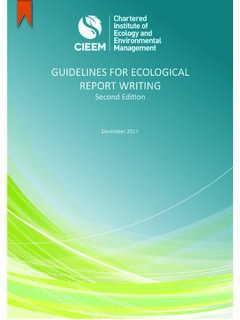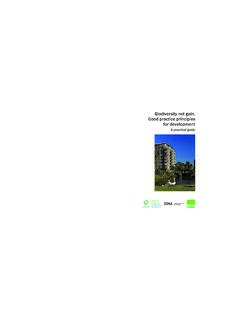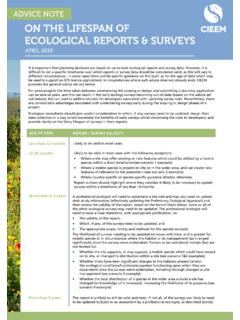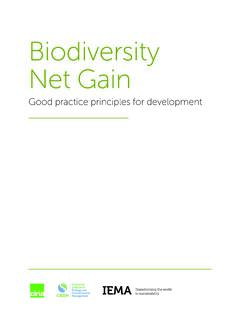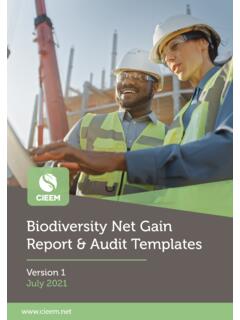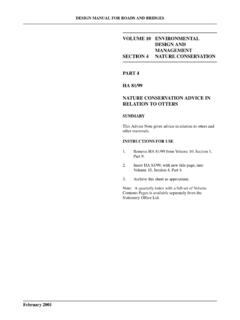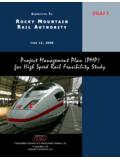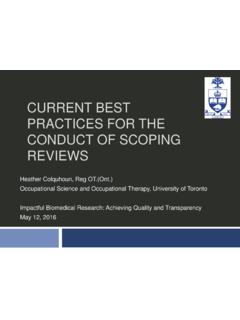Transcription of Guidelines for Preliminary ecoloGical aPPraisal
1 Guidelines for Preliminary ecoloGical aPPraisalSecond Editiondecember 2017 Guidelines for Preliminary ecoloGical aPPraisal (December 2017)PREFACE TO SECOND EDITIONThe Guidelines for Preliminary ecoloGical aPPraisal (2nd edition) have been produced by the Professional Standards Committee of the Chartered Institute of Ecology and Environmental Management (CIEEM). They were first published in 2012, authored by Ben Benatt CEnv MCIEEM (Halcrow Group Ltd, now part of CH2M) on behalf of the Institute. The aims of the Guidelines are to: promote good practice in undertaking Preliminary ecoloGical aPPraisal (PEA); and provide a common framework for PEA in order to promote better communication, understanding and cooperation between would like to thank all those involved in the production of this edition of these Guidelines especially Mike Dean CEcol CEnv FCIEEM who was the lead author.
2 Mike was assisted by a Working Group consisting of: Lisa Kerslake CEcol FCIEEM Mike Oxford CEcol FCIEEM David Smith MCIEEM Bob Edmonds CEnv MCIEEM Penny Lewns CEcol CEnv MCIEEM Ben Bennatt CEnv MCIEEMF urther expert input was provided by Jessica Boath ACIEEM, Kathy Dale CEcol FCIEEM, Jenny Neff CEcol CEnv FCIEEM and Michael Willis CEcol document should be referenced as: CIEEM (2017) Guidelines for Preliminary ecoloGical aPPraisal , 2nd edition. Chartered Institute of Ecology and Environmental Management, Institute of Ecology and Environmental Management43 Southgate Street, Winchester, Hampshire, SO23 9EH, UK+44 (0)1962 868626 | | 2 SECTION 1. The purpose of this guidance is to set out the appropriate approach to undertaking Preliminary ecoloGical Appraisals (PEAs) and the appropriate application of such assessments within the planning Preliminary ecoloGical aPPraisal (PEA) is the term used to describe a rapid assessment of the ecoloGical features present, or potentially present, within a site and its surrounding area (the zone(s) of influence1 in relation to a specific project (usually a proposed development)).
3 A PEA normally comprises a desk study and a walkover survey, the methods for which are further defined in Section 2 of these Guidelines . The key objectives of a PEA are to: identify the likely ecoloGical constraints associated with a project; identify any mitigation measures likely to be required, following the Mitigation Hierarchy 2; identify any additional surveys that may be required to inform an ecoloGical Impact Assessment (EcIA); and identify the opportunities offered by a project to deliver ecoloGical A flowchart is provided in Appendix 1, which sets out the appropriate approach to ecoloGical assessment for proposed development projects, and highlights the role of a PEA within that The results of a PEA can be presented in a Preliminary ecoloGical aPPraisal Report (PEAR).
4 The primary audience for a PEAR is the client or developer and relevant members of the project team, such as the architect, planning consultant, and landscape architect. It is normally produced to inform a developer (or other client), and their design team, about the key ecoloGical constraints and opportunities associated with a project, possible mitigation requirements and any detailed further surveys required to inform an ecoloGical Impact Assessment (EcIA). Under normal circumstances it is not appropriate to submit a PEAR in support of a planning application because the scope of a PEAR is unlikely to fully meet planning authority requirements in respect of biodiversity policy and implications for protected species. In the majority of cases, additional surveys beyond the PEA will be required.
5 In some scenarios, additional surveys will not be needed to allow an EcIA to be undertaken; this is particularly the case for sites where it is unlikely that protected or priority habitats or species (see Box 1 for definition) are present, or where they are unlikely to be affected by the 1. Protected and Priority Habitats and SpeciesLegal protection is afforded to particular habitats and species (as well as designated sites). The legislation, and the habitats and species listed, vary between the different jurisdictions4. Certain habitats and species are also considered to have some level of nature conservation importance, due to factors such as their rarity, vulnerability or declining population/status. This document uses the term priority habitats and priority species , as they are those which should be considered as priorities for conservation (it should not be confused with priority habitats and species as listed in the EU Habitats Directive).
6 Priority habitats and species are defined as those which are: 1) listed as a national priority for conservation (such as those listed as habitats and species of principal importance for the conservation of biodiversity5); 2) listed as a local priority for conservation, for example in the relevant local Biodiversity Action plan (BAP); 3) Red Listed using International Union for the Conservation of Nature (IUCN) criteria6 ( in an all-Ireland Red List7, in one of the UK Species Status Project8 reviews, in the Species of Conservation Concern Red List9, Birds of Conservation Concern in Wales,10 or BWI/RSPB Red List for Ireland and Northern Ireland (Birds of Conservation Concern in Ireland 2014 to 2019)11 or, where a more recent assessment of the taxonomic group has not yet been undertaken, listed in a Red Data Book).
7 4) listed as Near Threatened or Amber Listed in an all-Ireland Red List, in one of the UK Species Status Project reviews, in Birds of Conservation Concern in Wales,12 in the Species of Conservation Concern Amber List13 or BirdWatch Ireland (BWI)/RSPB Amber List for Ireland and Northern Ireland (Birds of Conservation Concern in Ireland 2014 to 2019)14; 5) listed as a Nationally Rare or Nationally Scarce species ( in one of the Species Status Project reviews) or listed as a Nationally Notable species where a more recent assessment of the taxonomic group has not yet been undertaken; and/or 6) endemic to a country or geographic location (it is appropriate to recognise endemic sub-species, phenotypes, or cultural behaviours of a population that are unique to a particular place).
8 Most protected species are also considered to be priority species, although there are some exceptions. There are numerous priority habitats and species which do not receive any legal protection. Note that the terms priority habitat and priority species used in this document differ from the following uses of the same terms: a) These terms were previously used to denote those habitats and species afforded the highest level of priority for conservation under the UK BAP; this has been superseded by the lists of habitats and species of principal importance for the conservation of biodiversity in England under Section 41 of the Natural Environment and Rural Communities (NERC) Act 2006, Section 7 of the Environment (Wales) Act 2016, or their equivalents in Scotland (Nature Conservation (Scotland) Act 2004, Scotland s Biodiversity Strategy and the Scottish Biodiversity List15) and Ireland (Actions for Biodiversity Ireland s National Biodiversity plan 2017 -202116; and Valuing Nature A Biodiversity Strategy for Northern Ireland to 2020).
9 B) The terms Priority Natural Habitat Type and Priority Species are used to denote specific lists of habitats and species under The Conservation of Habitats and Species Regulations 2017; these are defined in Articles 1(d) and 1(h) respectively of the Habitats It is not always necessary to produce a PEAR following a PEA, as the data could be written up directly in an EcIA Report instead (see Paragraph ). It is usually helpful, however, to produce a PEAR, particularly where there are numerous further surveys required (to inform an EcIA), or major ecoloGical constraints to a project which need to be communicated to the client, or a significant delay between undertaking the PEA and producing the A PEA is normally used to inform an ecoloGical Impact Assessment (EcIA).
10 In the context of these Guidelines , EcIA is defined as the process of identifying, quantifying and evaluating the potential effects of development-related or other proposed actions on habitats, species and ecosystems. These Guidelines should be read in conjunction with CIEEM s Guidelines for ecoloGical Impact Assessment in the UK and Ireland17. A PEA can also be used to inform, for example: scoping for an Environmental Impact Assessment (EIA18); an assessment as to whether a particular site should be included as an allocated site in a development plan ; nature conservation management plans; sustainability appraisals and ratings assessments ( BREEAM); or an assessment of likely compliance with statutory obligations for developments which do not require planning consent, or developments proceeding under Permitted Development Rights or other consented operations, such as Exempted Development in ireland19.
